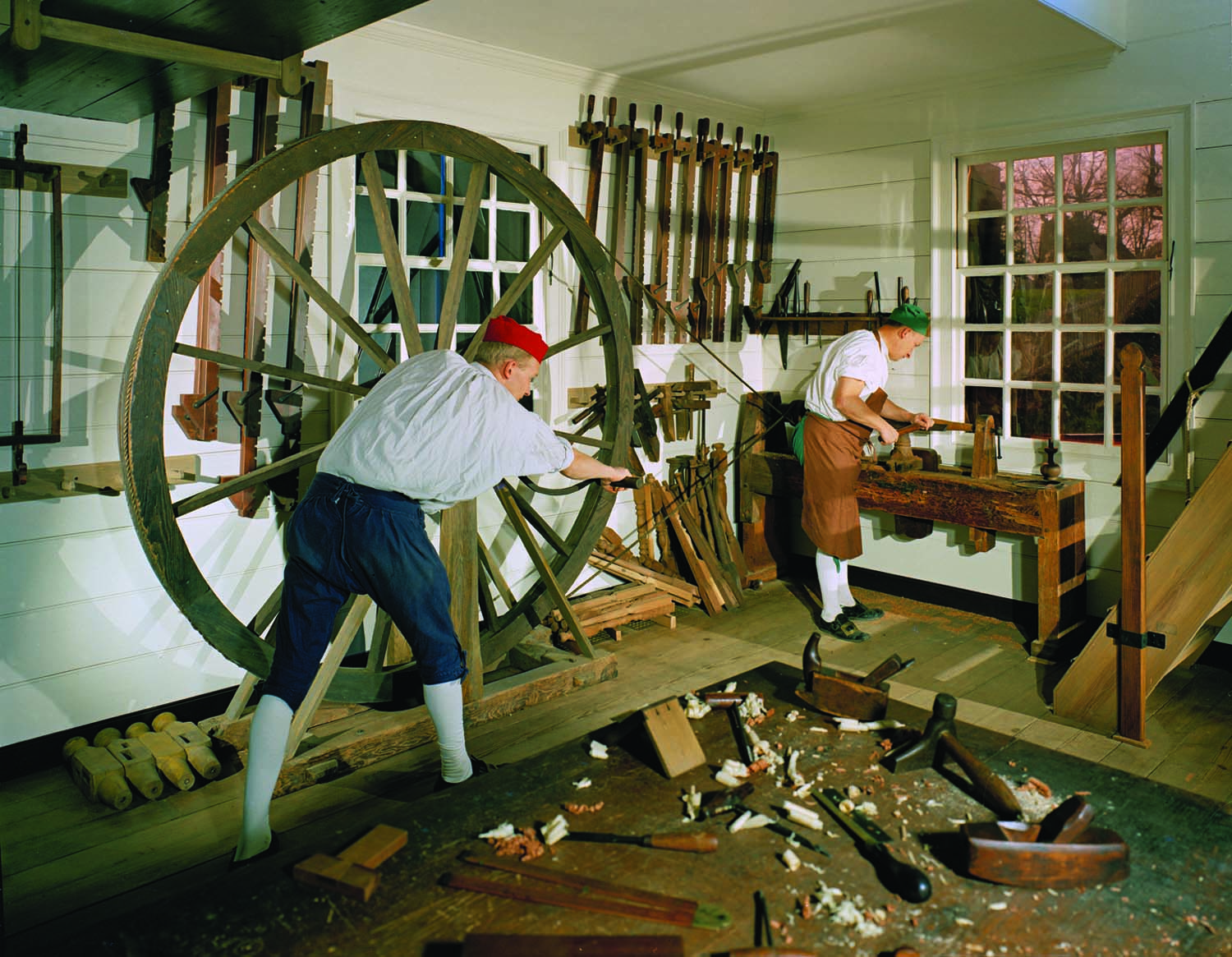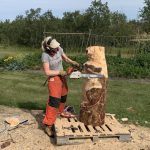We may receive a commission when you use our affiliate links. However, this does not impact our recommendations.

Interior of Cabinetmaker’s Shop showing tradesmen using wheel lathe
A boring task turns into a history lesson.
This article originally appeared in the April 2010 issue of Popular Woodworking
One day in Williamsburg, a message reached me at the carpenter’s yard that the cabinet shop was shorthanded and needed help. I figured it was some high-end task like dovetailing a chest or shaving cabriole legs, so I dropped my adze and headed to the cabinet shop across the creek.
I eased into the visitor-crowded shop and waited for a couple of Japanese honeymooners to get their photograph. Along the wall, I spied the work ahead – a great stack of heavy walnut spindle blanks, waiting by the lathe.
Well, I’m a pretty good turner, so I happily worked my way through the visitors toward the rack of polished gouges. Then I noticed that David, one of the shop’s journeymen, was already at the lathe, nodding toward the great wheel that drove it.
Oh, fair enough, I thought. I stepped over the rope, set my hands on the drive handle of the 6′-diameter wheel and began to crank. Slowly I worked it up to speed. The first 10 minutes were fine. I watched the leather drive belt pour from the top of the wheel over my head, run along the wall to the headstock pulley, and then rush back toward my feet. I counted the spindles in the stack. I watched the faint drift of brown shavings feathering to the floor.
I was craning my neck to see if there was any water in a mug on the windowsill when I felt a rap on my shoulder. I turned around to see a visitor ducking under the rope barrier. This was easy for him, because he was a little guy, old as my dad, but moving fast. I tried to form the words explaining that the ropes were for his protection, but I got only as far as taking in air before he pushed me away and grabbed the crank of the great wheel.
“Outta the way, kid,” he said in some New York accent. “Here’s d’way ya do it!”
I reached to direct him back across the rope into visitor world, but the room was transforming. I pulled back. Gone was the clattering roll of the wheel and the lazy cut of the turning. The great wheel was flying, and the floor was humming at a high-energy harmonic. David struggled to hang on to the gouge as a ribbon of sheared walnut hosed over his shoulder.
“Dat’s how ya do it kid; ya gotta put yer ass into it!” he shouted.
I knew this couldn’t last, but he kept it up, grinning and shaking his head, never flagging. He was still grinning as I reached out to him again. He grabbed me first and now had me turning the wheel as he ducked back under the rope. He stood there grinning.
“Dat’s it! Just put yer ass into it!”
I had no idea what he meant, but I then felt the belt slacken as David parted off the finished walnut spindle. I let the wheel slow.
“Never thought I’d do that again!” the guy said.
“What …?” was all I got out.
“I was in the ball turret of a B-17 durin’ the war. Two-six-two got us and next thing I know I’m in a parachute. I wake up with some Austrian farmer pokin’ me with his pitchfork. Marches me to his farm and puts me to work. For six months, ’til the end of the war, I’m turning this wheel for this farmer.” He rapped my shoulder hard in the way only old guys know. “The one thing I learned was, ya gotta put yer ass into it.”
As he faded back into the shuffling stream, I tried to re-establish boundaries by cranking up my historical interpretation. “The great wheel you see here …” Across the room I saw his head poke around to listen. I stopped short. Here’s this guy – one minute he’s flying along, next minute a jet shoots him down, next minute he’s cranking a great wheel on some Alpine farm in a scene out of the Middle Ages …
And I’m trying to teach him history.
Roy is the host of the PBS show “The Woodwright’s Shop,” and author of many books, including “The Woodwright’s Guide: Working Wood with Edge & Wedge” (UNC Press) from which this story is excerpted.
Here are some supplies and tools we find essential in our everyday work around the shop. We may receive a commission from sales referred by our links; however, we have carefully selected these products for their usefulness and quality.









